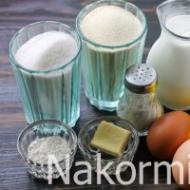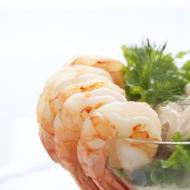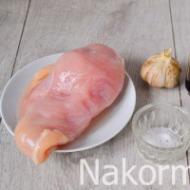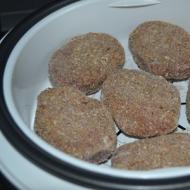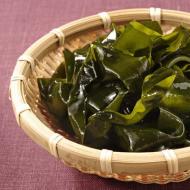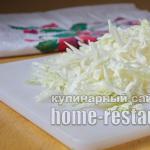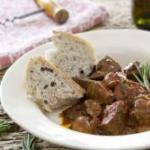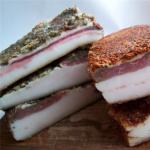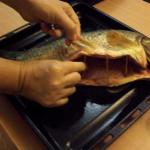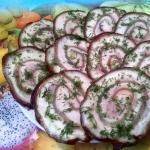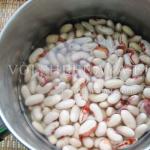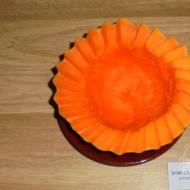
Homemade blood sausage (blood sausage) - recipes. My Ukrainian blood sausage (Krov'yanka) What can be prepared from ready-made blood sausage
The blood of domestic animals is a very tasty and nutritious product that can be consumed raw, boiled, fried and baked. The peoples of northern latitudes are great experts in using blood for food. In order to obtain high palatability of blood, they use methods such as calming the animal before slaughter, as well as proper bleeding. The blood is released from a slight cut in the artery and is drunk immediately. Quite often, such blood is mixed with fresh milk in various proportions and is a delicious dish. This custom existed among the Scythians, Pechenegs, Polovtsians and was in use among the Tatars. Since the time of the Tatar-Mongol yoke in Rus', the expression “blood with milk” has been preserved, which means nothing more than “healthy food”, since a person who consumed blood with milk was always healthy, strong and had an attractive appearance.
Krovyanka
Per 1 kg of blood:
100 g lard, 400 g stale bread, 1 egg, 2 glasses of milk, 10 hot peppercorns and 1 onion.
The blood of domestic animals is used to prepare the blood.
Soak the bun in milk, add blood strained through a sieve, lard cut into small cubes, chopped and slightly fried onions, raw eggs, ground hot pepper and salt. Mix everything well, stuff the intestines, tie them on both sides with twine, immerse them in salted boiling water, let them boil and cook at a low boil.
At the end of cooking, to prevent the sausage from bursting, the heat must be reduced even more.
To find out if the sausage is ready, you need to pull it out of the water and pierce it deeply with a needle. If clear juice comes out of the puncture, then the sausage is ready, but if it is bloody, you need to continue cooking.
Before serving, the blood is fried in oil.
Potato woman with blood
For 6 servings: 2 kg of potatoes, 750 ml of blood, 250 g of lard, 100 g of onion, 5 tbsp. l. breadcrumbs, 1 tbsp. l. flour, ground black pepper, marjoram, salt to taste.
Melt half the lard and fry the chopped onion in it. Peel the potatoes, grate them, mix with blood, breadcrumbs, flour, fried onions, salt, pepper and marjoram. Mix well and transfer to a well-greased and floured baking sheet. Place the other half of the lard on top, cut into thin slices, and bake in the oven.
Serve with bread and sauerkraut, cucumbers, beetroot or other vegetable salad.
Blood sausages with rice
Ingredients: 1 kg of fat pork, 1 kg of rice, 500 ml of blood, 70 g of onion, obor, ground black pepper, marjoram, cardamom, salt to taste, intestines.
Sort the rice, scald with boiling water, rinse thoroughly in cold water, add chopped onion, pour over the grease and simmer. (The rice should remain whole and crumbly.) Cut the meat into small cubes, render the fat out of them like lard, mix everything with the rice, add salt, add strained blood, pepper, marjoram and cardamom. Mix the mixture thoroughly and fill the prepared chopped colons with it, twist them tightly on both sides and secure with wooden sticks. Boil the sausages over low heat at 90°C for 10 minutes. (By piercing the sausage with a needle, you should make sure that the blood has coagulated.) Briefly immerse the finished sausages in cold water and place on a board to drain. Then bake in the oven, after piercing them with a needle and adding hot water.
Blood sausages with bun
Ingredients: 1 liter of blood, 600 g of pork, 250 g of rolls, cracklings, 50 g of onion, 2 cloves of garlic, ground black pepper, marjoram, cardamom, salt to taste, intestines.
Cut the stale rolls into very small cubes and dry them in the oven on a baking sheet. Cool, pour in well-stirred blood, add boiled and chopped meat into small cubes, some chopped greaves, salt, pepper, marjoram, cardamom, crushed garlic and finely chopped and fried onions. Fill the prepared chopped colons with thoroughly mixed minced meat, twist them tightly on both sides and secure with wooden sticks. Boil the sausages over low heat at 90°C for 15 - 20 minutes. (By piercing the sausage with a needle, you should make sure that the blood has coagulated.) Briefly immerse the finished sausages in cold water and place on a board to drain. Then bake in the oven, after piercing them with a needle and adding hot water.
Finnish blood sausage
0.5 l of pork blood, 0.5 l of milk or kvass, 6 tbsp. tablespoons chopped lard and pork liver, 1/2 teaspoon ground white and allspice, 2 tbsp. spoons of salt, 2 teaspoons of marjoram, 500-600 g of rye flour, 250-300 g of barley flour, 2 onions, intestines, fat.
Chop the onion and lightly fry in a frying pan with fat. Cut lard, meat and liver into small pieces and mix with milk or kvass, spices and fried onions. Add pre-mixed two types of flour, pour in the blood and mix thoroughly. At the same time, it is necessary to add flour and add liquid not all at once, but very carefully, making sure that the mass does not lose a certain degree of steepness: it should ultimately be such that if you press hard on it with a whorl during grinding, the mass would spread steeply curls of a characteristic shape. Only in this case can we assume that it is prepared correctly.
Separate a small piece from the prepared mixture and fry it for testing in a frying pan to check to what extent it is saturated with fat and how evenly the fat permeates the entire mass. If the piece browns evenly without burning or drying out excessively, then the mixture is prepared correctly. If there is too much or too little fat in the piece, then the mixture should be rubbed for a few more minutes.
Stuff the prepared mixture into the intestines so that they are not too tight and, tightly tying them at intervals, form sausages. Boil them in salted boiling water for about an hour, and then fry them in the oven (on a sheet of foil) or scorch them with straw.
Serve blood sausages hot with lingonberry sour jelly or pickled lingonberries.
Bloody gut
(Ukrainian food)
Option I
0.5 liters of blood, 1 kg of lungs, 0.5 kg of finely chopped lard, 5 onions, 4 kg of buckwheat or 4 kg of pearl barley, ground pepper, 200 g of salt, 15 g of cardamom, 15 g of marjoram, 6 g of cloves ( use pearl barley, marjoram and cloves as desired).
Soak the cereal in water, add lard or lard and bake in the oven. Boil the lungs, add lard and blood raw. Mix everything with spices and finely chopped onion. Stuff thin beef or large pork intestines with the resulting filling and cook them for about an hour.
Serve hot.
Option II
The blood collected during the slaughter of an animal must be beaten, salted and strained through a sieve or cloth. (You cannot use stale blood!) In addition to blood, add heart, lungs, lard and buckwheat to the filling (proportions to taste). Boil all this, chop finely and mix with blood. Then cook as in the first option.
(French cuisine)
Option I
2 liters of pork blood, 125 g of onions, 125 g of lard, 50 g of sour cream, 1 kg of interior fat, parsley, spices, salt, pork intestines.
The pork blood should still be warm. Pour a little vinegar into it to prevent curdling (10 g per 1 l). Turn out the pork intestines using a stick rounded on one side. Rinse them in several waters and clean with a soft brush.
Peel the onion, finely chop it and fry over low heat for 30 minutes in lard. Add sour cream, interior fat cut into small pieces, blood and seasonings: finely chopped parsley, spices, salt. Mix well and heat for 5 minutes. Using a funnel, introduce the prepared mixture into the intestines, without filling them too much. Throw the sausages prepared in this way into boiling water (they can be tied every 25 cm) and cook at low boil for 20 minutes. If no blood comes out when the sausage is heated, the boudin is ready.
Let the water drain, wipe the sausage and, if desired, rub with lard skin to make it shiny.
Option II
Cut the blood sausage (boudin) into the required number of servings, prick the skin with a fork, place on the grill and fry over coals at moderate heat for 12-15 minutes, turning occasionally.
Option III
Blood sausage (boudin), prepared as in the first option, place in a frying pan with heated oil and fry at moderate heat for 12 minutes.
Fried blood sausage is served hot with mustard.
Homemade blood sausage
(From ancient recipes)
1 kg of pork blood, 0.5 kg of meat and fatty trimmings, 20-25 g of salt, ground black pepper, ground allspice, water, intestines.
Stir the collected pork blood, add salt and place in a cool place for one hour. Grind the meat trimmings along with the fat, add salt, ground black and allspice and mix with the blood. Stuff the large pork intestines with the mixture and tie the ends with twine.
Place the prepared sausages in a cauldron, add water and cook at low boil until cooked. During cooking, pierce the sausages in several places with a needle. If no blood comes out, the sausages are ready. They should be removed from the cauldron and cooled in a suspended state. Serve cold.
(Estonian cuisine)
Option I
0.5 liters of blood, 1 glass of milk or water, 3-4 glasses of rye or barley flour, salt, fat.
Strain the blood, add milk or water, salt, flour, mix thoroughly and fry.
Serve hot with lingonberry or cranberry salad.
Option II
2.5 cups of blood, 1/2 cup of curdled milk (kvass or beer), 10 g of bacon, 1 large onion, 3-4 cups of rye or barley flour, 1 teaspoon of soda, fat, salt, spices.
Strain the blood, add curdled milk, kvass or beer, bacon, cut into cubes, melted in a frying pan and fried with onions, add flour and soda, season with spices and fry small pancakes in a frying pan with fat.
Serve hot.
Coat *Pataveri*
(Finnish cuisine)
0.5 liters of pork blood, 1 glass of kvass (water), 300 g of rye flour, 50 g of barley flour, 50 g of wheat flour, salt, 1/g teaspoon of marjoram and white (black) pepper, 2 liters of meat broth .
Stir the fresh blood, beat it, pour kvass into it and stir some more. Then mix with three types of flour, salt, and spices. Form babushkas from this dough.
Boil the prepared meat broth in a saucepan and blanch the bloody grannies in it, removing them and throwing them into a colander. Then boil them in meat broth for 20 minutes. Readiness can be checked as follows: after 20 minutes from the start of cooking, take out one granny, cut it and if it is dark brown in the very middle, then the dish is ready. Remove all the palten from the broth, place in a colander, and allow the liquid to drain.
Serve hot on a heated platter with pickled lingonberries, lingonberry broth or garlic seasonings (garlic sauce) as a hot lunch dish.
Palten were always eaten only hot, piping hot, since dishes that contain blood do not tolerate heating well, and when cooled, as a rule, they are tasteless. But if the palten still remains in the refrigerator the next day, then, as experience shows, they should only be heated in boiling milk to restore the original taste.
Blood casserole
(Lithuanian cuisine)
125 g pork blood, 45 g barley, 35 g rendered lard, 5 g juniper berries, ground black pepper, salt.
Wash the barley, brew with boiling water, let it swell, pour in the strained pork blood, rendered lard, add salt, pepper, juniper berries and mix well. Place the prepared mass in a frying pan greased with oil and sprinkled with crushed breadcrumbs and bake for 30 minutes in the oven.
Pork blood
Boil pork blood in water and place in a sieve. Fry 2 finely chopped onions in lard.
Grind the blood. Mix everything together, add salt and fry.
Fried goose blood
(Hungarian cuisine)
Blood of one goose, 100 g of milk, 50 g of bread, 50 g of lard, 50 g of onions, ground black pepper, salt.
Pour milk over the loaf for 15-20 minutes, knead it and add fresh goose blood to it. Heat the lard, stew the onion in it, add a mixture of blood and milk, add salt and, stirring constantly, fry over medium heat until the blood darkens in the middle, then add pepper. Serve with any side dish.
Most types of sausages are made primarily from meat. Of course, it requires various additives (at least the same spices), but the main component is still pork (beef, horse meat, chicken, etc.). Another thing is blood sausage. It, of course, also includes minced meat, but the main ingredient in it is still blood. There are various recipes for blood sausages in almost all countries. Somewhere the “liquid component” should be bovine, somewhere sheep, somewhere pork, but it is everywhere. And if previously homemade blood sausage was available only to those who kept livestock on the farm, now all the ingredients can be purchased and cooked with your own hands.
Fighting prejudices
Some people are very hesitant about this dish. They say that since there is blood in it, then those who eat it are almost vampires. However, the long history of the existence of such sausage and the variety of recipes make such a point of view simply ridiculous. In addition to the amazing taste of these products, they are also very useful for humans. Blood is a life-giving substance, and sausage made from it helps improve blood formation due to the incredible amount of vitamins and iron it contains. It is not for nothing that doctors strongly recommend that pregnant women (and those women who are planning to conceive a child) and people who have undergone chemotherapy eat it. So it's wise to put aside any preconceptions you might have about blood sausage.
Who will have to give up blood
She has practically no contraindications, except perhaps being overweight. Yet black pudding is very nutritious, and can further increase this excess. The only thing you need to be extremely careful about is: if you are planning blood sausage for dinner (you want to make it yourself at home), then the animals whose body parts will be used in preparing the product must be absolutely healthy. So it’s better to buy everything you need in trusted places controlled by the sanitary service, and not in spontaneous markets.

Subtleties of cooking
First of all, the most important thing is the ingredients. Purchased intestines may be cleaned; even if this is the case, they must be washed thoroughly and then soaked in salt water for a couple of hours. But sometimes you come across uncleaned offal. In this case, you will have to carefully turn them out and remove the inner film with a non-sharp object. The second important component is blood. If you managed to purchase fresh meat, immediately after slaughter, salt it so that it does not curdle. Before stuffing, the blood must be filtered, and the clots are rubbed through a colander or turned through a meat grinder.

Now about the technology of “pushing” minced meat into the intestines. Many meat grinders have special attachments for sausages. If you don’t have such a device, build yourself a watering can from a plastic bottle: cut off the neck with half the volume of the bottle and attach one end of the intestine to it. You can push the minced meat with the handle of a fork or a pusher. You should not stuff it too tightly - during heat treatment, too-tight sausages may burst.
And lastly: at the end of cooking, the blood sausage is either fried or boiled. In any case, it must be pierced with a needle in several places to allow steam to escape.

Bloody milk without porridge
This is the easiest recipe. Unsalted pork lard (one and a half kilos) is taken, the skin is cut off, and it is finely chopped or ground. 5 cloves of garlic are crushed, mixed with lard, three liters of blood and a shot of cognac (high-quality vermouth, sherry or Madeira are also suitable). The filling is flavored with salt and spices (any pepper, nutmeg, cumin, cloves - whatever you want). One end of the intestine is tightly tied with a thread, through the other the blood sausage is filled with minced meat. A large container (basin, pan, bucket) is placed on the fire, warm water is poured into it - and onto the fire. After boiling, your homemade blood sausage will cook for half an hour. The finished product is carefully removed and cooled. You can eat!
Blood sausage with barley
Most often, blood milk is prepared with some kind of cereal. In our area, pearl barley and buckwheat are the most popular, with rice in second place. If you choose pearl barley, then 1 kilogram of it should be washed and boiled in salted water until soft, but still crumbly. About half a kilo of smoked lard is chopped, about 6 onions are chopped, everything is mixed with porridge and seasoned with spices. This blood sausage recipe is especially successful if it is supplemented with marjoram or oregano in addition to the usual seasonings. When the porridge has cooled, one and a half liters of blood are poured into it, and everything is mixed. The intestines are stuffed with minced meat, and the tied sausages are boiled for 10 minutes in salted water. Before serving, they should be fried in the oven or in a frying pan.

Filling with buckwheat
The preparation offered by this blood sausage recipe differs significantly from the previous version. A glass of cereal is poured with boiling water for a quarter of an hour. At this time, 300 g of meat (most often pork) and 200 g of fresh lard are cut into small pieces, salted, peppered and browned. A liter of blood is carefully poured into the prepared base, the strained cereal is poured in, and the filling is kneaded until the blood thickens. At the end, an incomplete glass of milk is added - and again the contents of the pan are mixed. When the minced meat has cooled, the intestines are stuffed with it and tied securely. Blood sausage with buckwheat is not cooked: it is placed in a frying pan and fried on both sides.
Well, in fact, the emergence of this topic is due to the fact that some of the products after hunting are rarely used for food. Well, in conditions of survival it is necessary to use all opportunities. Next there will be blood dishes, people with weak stomachs should read at their own peril and risk.
The blood of domestic animals is a very tasty and nutritious product that can be consumed raw, boiled, fried and baked. The peoples of northern latitudes are great experts in using blood for food. In order to obtain high palatability of blood, they use methods such as calming the animal before slaughter, as well as proper bleeding. The blood is released from a slight cut in the artery and is drunk immediately. Quite often, such blood is mixed with fresh milk in various proportions and is a delicious dish. This custom existed among the Scythians, Pechenegs, Polovtsians and was in use among the Tatars. Since the time of the Tatar-Mongol yoke in Rus', the expression “blood with milk” has been preserved, which means nothing more than “healthy food”, since a person who consumed blood with milk was always healthy, strong and had an attractive appearance.
Krovyanka
Per 1 kg of blood:
100 g lard, 400 g stale bread, 1 egg, 2 glasses of milk, 10 peppercorns and 1 onion.
The blood of domestic animals is used to prepare the blood.
Soak the bun in milk, add blood strained through a sieve, lard cut into small cubes, chopped and slightly fried onions, raw eggs, ground hot pepper and salt. Mix everything well, stuff the intestines, tie them on both sides with twine, immerse them in salted boiling water, let them boil and cook at a low boil.
At the end of cooking, to prevent the sausage from bursting, the heat must be reduced even more.
To find out if the sausage is ready, you need to pull it out of the water and pierce it deeply with a needle. If clear juice comes out of the puncture, then the sausage is ready, but if it is bloody, you need to continue cooking.
Before serving, the blood is fried in oil.
Finnish blood sausage
0.5 l of pork blood, 0.5 l of milk or kvass, 6 tbsp. tablespoons chopped lard and pork liver, 1/2 teaspoon ground white and allspice, 2 tbsp. spoons of salt, 2 teaspoons of marjoram, 500-600 g of rye flour, 250-300 g of barley flour, 2 onions, intestines, fat.
Chop the onion and lightly fry in a frying pan with fat. Cut lard, meat and liver into small pieces and mix with milk or kvass, spices and fried onions. Add pre-mixed two types of flour, pour in the blood and mix thoroughly. At the same time, it is necessary to add flour and add liquid not all at once, but very carefully, making sure that the mass does not lose a certain degree of steepness: it should ultimately be such that if you press hard on it with a whorl during grinding, the mass would spread steeply curls of a characteristic shape. Only in this case can we assume that it is prepared correctly.
Separate a small piece from the prepared mixture and fry it for testing in a frying pan to check to what extent it is saturated with fat and how evenly the fat permeates the entire mass. If the piece browns evenly without burning or drying out excessively, then the mixture is prepared correctly. If there is too much or too little fat in the piece, then the mixture should be rubbed for a few more minutes.
Stuff the prepared mixture into the intestines so that they are not too tight and, tightly tying them at intervals, form sausages. Boil them in salted boiling water for about an hour, and then fry them in the oven (on a sheet of foil) or scorch them with straw.
Serve blood sausages hot with lingonberry sour jelly or pickled lingonberries.
Homemade blood sausage
(From ancient recipes)
1 kg of pork blood, 0.5 kg of meat and fatty trimmings, 20-25 g of salt, ground black pepper, ground allspice, water, intestines.
Stir the collected pork blood, add salt and place in a cool place for one hour. Grind the meat trimmings along with the fat, add salt, ground black and allspice and mix with the blood. Stuff the large pork intestines with the mixture and tie the ends with twine.
Place the prepared sausages in a cauldron, add water and cook at low boil until cooked. During cooking, pierce the sausages in several places with a needle. If no blood comes out, the sausages are ready. They should be removed from the cauldron and cooled in a suspended state. Serve cold.
Khoto - Kalmyk blood sausage
Collect the blood of a freshly slaughtered animal (ram, horse, cow) in a cup, add salt, add finely chopped internal fat, a glass of flour, half a glass of milk or 2 tbsp. spoons of sour cream, mix well and fill with intestines, cleaned with salt and washed in cold water. Tie the ends of the intestines with threads and, after making several punctures with a needle, cook until tender.
(Khakassian cuisine)
Drain the blood from the carcass of a freshly slaughtered sheep, mix it with milk, salt, pepper, green onions and onions. Fill the treated small intestines with the resulting mixture and tie the ends in knots. Boil the khan in meat broth, being careful not to overcook it, remove, cut into portions and serve.
Blood sausage
Option I
1 m of colon, 1.2 liters of beef blood, 30 ml of milk, 30 g of beef fat, 50 g of onions, salt.
Prepare minced meat from blood, milk, finely chopped onions and fat. Rinse the colon thoroughly, stuff it with minced meat and boil the sausage for 20 minutes, tying both ends.
Option II
600 ml of ox blood, 400 g of pearl barley, 80 g of pork fat, 120 g of onions, 160 g of intestines, salt, spices.
Boil pearl barley in water until half cooked and cool, then add ox blood, spices, thinly sliced stewed onions, diced and fried pork lard. Fill the intestines with this mixture, securing the ends. Cook the sausage for 10-15 minutes and then fry in the oven.
Fried pork and bacon, beet or lingonberry salad, and oven-fried potatoes are recommended as a side dish for blood sausage.
Pancakes
(Nenets cuisine)
60 g beef or deer blood, 60 g water, 75 g wheat flour, margarine, salt.
Dilute fresh blood with water (1:1), add salt, flour and knead the dough as for pancakes. Melt margarine in a frying pan and bake pancakes.
Serve the finished pancakes with butter.
Pork blood
Boil pork blood in water and place in a sieve. Fry 2 finely chopped onions in lard.
Grind the blood. Mix everything together, add salt and fry.
Cuajada
(Cuban cuisine)
This delicious, widespread dish in Cuba is made from the blood of pigs and lamb.
Before slaughtering an animal, you need to place a deep bowl under it, into which you should pour about half a liter of water and put a tablespoon of salt. The blood must be stirred all the time while it is draining so that it does not clot. Then pour it into a frying pan, in which you first need to fry the onions, garlic, parsley and spices: marjoram, cumin, etc.
Cook over low heat, adding raisins, olives and capers to taste, as well as a little dry sherry and salt.
Blood sausage, the benefits and harms of which were known several centuries ago, is still prepared according to ancient recipes. It is valued for its excellent taste and unique composition. The basis for its production is meat and fresh blood. All other ingredients may vary depending on the recipe.
Composition and energy value of the product
Blood sausage, the benefits and harms of which are due to the high content of vitamins and microelements, is a good source of complete protein and vital amino acids. It contains quite a lot of valine, tryptophan, lysine and histidine.
It is also rich in vitamins D, PP and B. Blood sausage contains large amounts of sodium, phosphorus, calcium, magnesium, potassium, zinc, manganese and iron. The calorie content of 100 grams of this product is 379 kcal.
Blood sausage: benefits
Both the harm and the valuable properties of the product are due to its unique composition. It helps the body recover faster after undergoing chemotherapy. Therefore, it is recommended to regularly use it for cancer patients.

Blood sausage is rich in vitamins and minerals that support a healthy nervous system. And the increased content of amino acids and protein makes this product an indispensable component of the diet of professional athletes and people engaged in heavy physical labor. In addition, the bloodstream contains a high concentration of iron, so it is advisable to include it in the menu of those who suffer from anemia. This product helps improve the quality characteristics of red blood cells, normalize metabolic processes and speed up wound healing.
Who should not use this product?
Like any other food, blood sausage, the benefits and harms of which are described in today’s article, has several contraindications. It is quite high in calories, so it should be excluded from the diet of obese people. In addition, regular use of this product can provoke the appearance of edema and the development of atherosclerosis.

Poorly processed workpieces often lead to helminthiasis. And too frequent use of this product can lead to a change in the composition of the blood and an increase in its viscosity. Therefore, it should be excluded from the diet of older people prone to blood clots.
You don't have to use fresh blood to make this sausage. If necessary, this ingredient can be completely replaced with dried food albumin. It is a powdery substance that must be diluted with water. Albumin can be stored in a dry place for about three years.
To prevent the finished products from drying out or becoming chapped, after cooking, rub their surface with any vegetable oil. Thanks to these simple steps, you can not only maintain the attractive appearance of the product, but also protect it from bacteria.

You can preserve natural intestines using regular salt. The product sprinkled with it is placed in a hermetically sealed container and put in the refrigerator. Intestines stored in this way remain strong and elastic for several months.
Any remaining blood can be stored in the freezer. There they can be stored for a year. Thawed blood does not lose its taste and is suitable for further use.
In order for the baked product to acquire a crispy golden brown crust, before putting it in the oven, grease its surface with a small amount of butter.
Homemade krovyanka with buckwheat: set of ingredients
A dish prepared using the technology described below turns out to be very aromatic, satisfying and tasty. It is served not only cold, but also hot. Boiled potatoes or baked vegetables are often used as a side dish. Since this blood drink recipe requires the availability of certain products, you need to go to the market in advance and purchase everything you need. In this case you will need:
- Three liters of pig blood.
- One and a half kilograms of lard.
- Four eggs.
- Half a kilo of buckwheat.
- Ten meters of pig intestines.
- Half a liter of milk.

To make truly delicious blood sausage at home, you need to make sure you have some salt, garlic and ground black pepper on hand. These components will give the dish a pleasant aroma and taste. In addition, you will need a small amount of fat. It is used for lubrication.
Process description
Before you make homemade blood sausage, you need to fry the lard. It is cut into small cubes, placed in a frying pan and heated. When the lard is browned, it is combined with buckwheat cooked until tender and pork blood. Raw eggs are beaten into the total mass and milk is poured in. Salt, pepper, season everything with chopped garlic and mix well.
The minced meat prepared in this way is placed in a previously cleaned and washed intestine, one end of which is tied with thread. The resulting semi-finished product is placed in a pan with cold water and brought to a boil. Cook blood sausage at home over low heat for ten minutes. After this, it is removed from the pan, placed on a baking sheet, the bottom of which is greased, and sent to the oven. Bake the product at two hundred degrees until a golden brown crust appears. As a rule, the duration of this process does not exceed twenty minutes.
Blood soup with cream: list of products
Using this technology you can make delicious homemade sausage relatively quickly. This recipe for bloodwort involves the use of simple, budget ingredients that can be bought at any store or market. To create this dish you will need:
- A liter of fresh blood.
- 350 grams of pork meat.
- Half a kilo of lard.
- A couple of glasses of buckwheat porridge.
- Two heads of onions.
- A tablespoon of vinegar.
- Two hundred grams of cream.
Sequencing
At the initial stage, you should deal with lard. It is cut into large pieces and fried in a frying pan. The browned lard is placed in a separate container, and chopped onions are added to the rendered fat and fried.

The washed pork, cooled lard and onions are ground using a meat grinder. Fresh blood, previously combined with vinegar, is poured into the resulting minced meat. Cream and crumbly, but not boiled, buckwheat porridge are also sent there. Mix everything well, season with salt, cloves, nutmeg and black pepper.
The resulting fairly liquid minced meat is stuffed into pre-prepared intestines, pierced and dipped into boiling water. After about 50 minutes, the blood cream and buckwheat is completely ready for consumption.
Cooking blood sausage at home is scary only the first time. The main thing is to tune in and find the necessary products. If you can get hold of fresh pork blood, intestines or sausage casings, then confidently begin preparing a delicious dish. This result of your efforts will be highly appreciated by both family and guests.
Recipe No. 1. Blood sausage with cream
Blood sausage is made with the addition of liver (liver, lung, kidneys, heart), various cereals (buckwheat, pearl barley, millet, rice, semolina), onions, eggs and even apples. In our step-by-step recipe, we suggest trying bloodwort with cream; its taste is very juicy and delicate.
TIME: 2 hours 30 minutes.
Difficult
Servings: 8
Ingredients
- Fresh blood - 2 liters;
- Cream with a fat content of at least 33% - 0.5 liters;
- Lard - 300 g;
- Garlic (peeled cloves) - 0.5 cups;
- Salt - 1 tbsp. with a slide;
- Ground pepper - 1 tsp;
- Cleaned thin intestines - 3 m.

Preparation
Fresh hot blood is slightly salted and vigorously mixed with a wooden spoon, collecting fibrin, which enhances blood clotting.
Next, the blood is boiled in water at a low boil for 40-60 minutes, stirring regularly, then placed on a sieve (to allow the water to drain).
Grind lard, boiled blood and peeled garlic in a meat grinder.
Add cream, salt, pepper to the mixture and mix everything well. 
Cut the intestines into pieces of the required length (no more than 1 meter).
The intestines are thoroughly washed, then they are turned inside out and carefully (so as not to tear) rubbed with salt.
After 6-7 hours, the intestines are washed from mucus, soaked for a day in a vinegar solution and washed again. If the smell remains, repeat the procedure.
Check the intestines for integrity by taking a little water into them and moving it along the entire length.
Tie the lower end of the intestine with a strong thread.
Fill the intestine with minced meat using a meat grinder (removing the knife and grid) with a special attachment, or manually, putting the end of the intestine on the cut off neck of a plastic bottle. The intestines should not be filled tightly - they may burst during cooking.
Having filled the intestine, tie it up and distribute the minced meat evenly along the entire length. 
The prepared sausages are pierced 10-15 cm along the entire length with a toothpick to let the air out, carefully lower several rings into a pan of boiling water and cook over low heat for 20 minutes (if the boiling is strong, the intestines may burst).
Then the rings are carefully removed from the pan, cooled (preferably with cold water) and allowed to dry a little. 
Boiled sausages are poured with lard and baked in the oven for about 30 minutes at medium temperature.
The readiness of the product is determined by piercing the shell with a toothpick or fork. If the juice that flows out is clear (without blood), then the sausage is ready.
A crispy, beautiful, appetizing crust should form on the sausage. 
Recipe No. 2. Blood sausage with semolina
The originality of this cooking method lies in the fact that here semolina is added to the minced meat (not ready-made porridge, but cereal).
Ingredients:
- Fresh blood - 3 l;
- Semolina - 2 cups;
- Lard (without skin) - 1.5 kg;
- Salt, pepper, garlic - to taste;

Home cooking:
The lard is boiled and ground in a meat grinder, at the same time as the blood.
Add semolina, salt, pepper, garlic to the mixture and leave to swell (about an hour).
The intestines are filled with the mixture, both ends are tied, several punctures are made in the shell and boiled in boiling water over low heat for about 20 minutes. Then the sausages are fried in a frying pan or baked in the oven.
Recipe No. 3. Homemade blood sausage in Ukrainian
A real Ukrainian blood sausage is the one prepared with liver and buckwheat!
Ingredients:
- Pork blood - 1 l;
- Milk - 1 glass;
- Buckwheat (already boiled, crumbly) - 2 cups;
- Liver (liver, lung, kidneys, heart) - 500 g;
- Lard (without skin) - 250 g;
- Onion - 1 piece;
- Seasonings and salt - to taste;
- Guts (already cleaned and prepared).

Preparation of Ukrainian blood milk:
The lard is twisted in a meat grinder with a large wire rack and fried in a frying pan for 10-15 minutes.
The onion is also chopped in a meat grinder, added to the lard and fried for 5 minutes. Cool everything to room temperature.
The liver is cut into small cubes or passed through a meat grinder.
Beat the blood with a blender until smooth.
Mix liver, lard with onions, blood, buckwheat, milk, salt and seasonings.
The intestines are filled with minced meat, the sausages are tied into a ring and boiled, and then fried or baked.
Home testing of blood suitability for consumption:
- It is shaken well and filtered through a sieve;
- Then pour a little blood onto the palm;
- Make small movements with your palm;
- If the blood spreads easily and evenly stains the palm, it is suitable for use.
- It is better to use bovine blood - pork and veal blood do not harden well during cooking.
- Fresh blood with a little salt added (closed tightly) can be stored in the refrigerator for 3 days.
- You can use frozen blood to make homemade bloodletting. It is stored in a glass jar for a year in the freezer. To defrost, the blood is left at room temperature or placed in a pan of warm water.
- To prepare homemade blood sausage, dried pork blood (food albumin) is also used, which is diluted simply with water in a ratio of 1:2.5 immediately before adding to the minced meat. It can be stored for 2 years in a dry place at room temperature.
- The intestines, sprinkled with salt, are stored in a glass jar in the freezer for a whole year, then they lose their elasticity.
- The finished semi-finished product (boiled sausages) is taken out of the pan, thoroughly greased with vegetable oil on all sides (so that the casing does not dry out and as protection against bacteria) - in this form the sausage is stored in the refrigerator for 2-3 days.
- For longer storage, the sausage is cut in several places (to be broken off as needed) and stored in the freezer. Defrost the sausages slowly (overnight in the refrigerator) or in the microwave in defrost mode.
- It is recommended to serve sausages with bread and garlic sauce; Ukrainians like to eat them with grated white horseradish.

